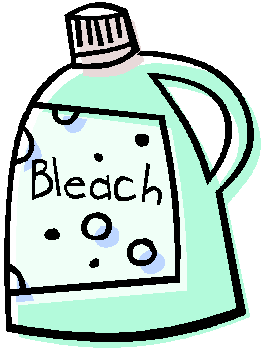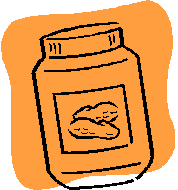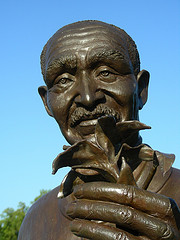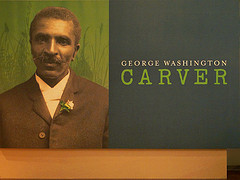
George Washington Carver and other uses
 The peanut is a vital and useful crop around the world. From
food to fertilizer, every part of the peanut has a variety of
uses. The seed, or nut, itself is quite
The peanut is a vital and useful crop around the world. From
food to fertilizer, every part of the peanut has a variety of
uses. The seed, or nut, itself is quite nutritious, full of things your body needs like proteins and
carbohydrates, and most often used as a food source. It is
usually eaten whole, either raw, roasted, or broiled, or as an
oil. In fact, peanut oil is so commonly made that it makes the
peanut the fifth most important oilseed in the world, beaten
only by soybean,
palm, colza, and sunflower. The other parts of the plant,
such as the shells and greens, are utilized for animal feed or
non-food uses. These non-food uses range from fuel for burning
to being an ingredient in shampoo. Other such non-food uses in
which some part of the peanut are
nutritious, full of things your body needs like proteins and
carbohydrates, and most often used as a food source. It is
usually eaten whole, either raw, roasted, or broiled, or as an
oil. In fact, peanut oil is so commonly made that it makes the
peanut the fifth most important oilseed in the world, beaten
only by soybean,
palm, colza, and sunflower. The other parts of the plant,
such as the shells and greens, are utilized for animal feed or
non-food uses. These non-food uses range from fuel for burning
to being an ingredient in shampoo. Other such non-food uses in
which some part of the peanut are ingredients include, but are
not limited to, kitty litter, paper, bleach, shaving cream,
linoleum, cosmetics, paint, and explosives.
ingredients include, but are
not limited to, kitty litter, paper, bleach, shaving cream,
linoleum, cosmetics, paint, and explosives.
 I'm
sure that most of us have, at some point in our lives, heard of
George Washington Carver, the Peanut Man. Contrary to his name, the
Peanut Man did more than just work with peanuts. Carver also worked
on coming up with more uses for the sweet potato and cowpea. In
1916, Carver wrote his most famous bulletin,
How to Grow the Peanut and 105 Ways of Preparing it for Human
Consumption. However, it wasn't until 1921 when he lobbied
to Congress on behalf of the peanut industry that Carver became well
known. People were so impressed with his work with peanuts that he
was shot into the limelight and
I'm
sure that most of us have, at some point in our lives, heard of
George Washington Carver, the Peanut Man. Contrary to his name, the
Peanut Man did more than just work with peanuts. Carver also worked
on coming up with more uses for the sweet potato and cowpea. In
1916, Carver wrote his most famous bulletin,
How to Grow the Peanut and 105 Ways of Preparing it for Human
Consumption. However, it wasn't until 1921 when he lobbied
to Congress on behalf of the peanut industry that Carver became well
known. People were so impressed with his work with peanuts that he
was shot into the limelight and given credit for discoveries he did
not make or claim to have made, such as peanut butter. Even though
Carver may not be responsible for all the peanut discoveries he is
accredited with, he is still responsible for making the peanut
famous and allowing the industry to prosper.
given credit for discoveries he did
not make or claim to have made, such as peanut butter. Even though
Carver may not be responsible for all the peanut discoveries he is
accredited with, he is still responsible for making the peanut
famous and allowing the industry to prosper.
There are countless recipes involving peanuts that can be found in cookbooks or on the internet. Here is just one of my favorites. It is a peanut butter frosting that goes great on chocolate cakes:
Ingredients:
1/2 cup butter, softened
1 cup creamy peanut butter
3 tablespoons milk, or as needed
2 cups powdered sugar
Directions:
1. Place the butter and peanut butter into a medium sized bowl and
beat with an electric mixer.
2. Slowly and gradually mix in the sugar.
3. When the mixture starts to get thick, add milk the one tablespoon
at a time until all of the sugar is mixed in and the frosting is
thick and spreadable.
4. Continue beating for at least 3 minutes until the frosting is
light and fluffy.
Makes about 2 cups of frosting.
For more examples of peanut recipes, please click on the link above to see the 105 recipes George Washington Carver himself thought were worth trying. Other good places to look are cookbooks or internet searches.
Peanut allergies are very common and can range from mild to lethal. If you happen to be allergic to peanuts, please stay strong and ignore the call of this lovely legume. For more information on peanut allergies, please visit http://www.peanutallergy.com/.